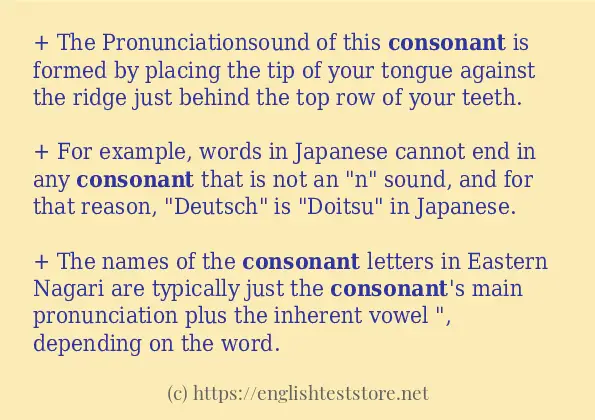How to use in-sentence of “consonant”:
+ The Pronunciationsound of this consonant is formed by placing the tip of your tongue against the ridge just behind the top row of your teeth.
+ For example, words in Japanese cannot end in any consonant that is not an “n” sound, and for that reason, “Deutsch” is “Doitsu” in Japanese.
+ The names of the consonant letters in Eastern Nagari are typically just the consonant‘s main pronunciation plus the inherent vowel “, depending on the word.
+ In some abugidas, certain vowels can be written to the right, to the left, on top, or below the consonant that is spoken before it, even if the reading order of the consonants must all be left-to-right or right-to-left.
+ More telling, the impenetrable green enclosure—heightened in the National Gallery painting by the placement of the top of the bridge’s arch just below the painting’s top edge—harkens back to the “hortus conclusus” of medieval images, while also evoking a dreamlike contemplative zone consonant with symbolist literature, especially poems such as “Le Nénuphar blanc” by Stéphane Mallarmé.
+ Other difficulties include silent letters and consonant mutations.
+ By themselves, the consonants that make up the “kh + m” cluster would be written as ខ and ម, but since the “m” consonant is the second part of a consonant string, it is written differently under the first consonant in the cluster ខ.

Example sentences of “consonant”:
+ If a contestant has a Wild Card in the bonus round, a fourth consonant is called.
+ For short adjectives ending in a consonant like "cold" "black" or "fast" one adds the suffix er to make a comparison of greater magnitude.
+ If a contestant has a Wild Card in the bonus round, a fourth consonant is called.
+ For short adjectives ending in a consonant like “cold” “black” or “fast” one adds the suffix er to make a comparison of greater magnitude.
+ A consonant is a speech sound in which the air is at least partly blocked, and any letter which represents this.
+ It has sequences of consonants and vowels that are written as a unit, each based on the consonant letter.
+ A consonant interval or chord is one which sounds stable and pleasant.
+ A nasal consonant is a type of consonant produced with a lowered velum in the mouth, allowing air to come out through the nose, while the air is not allowed to pass through the mouth because something is stopping it.
+ Similarly the name ‘Tarun’ would not have its first consonant sounded as in ‘Tom’.
+ The 22-Shruti-Harmonium enables the creation of any Raga with all the notes perfectly consonant with a Tanpura.
+ Abugidas are alphabets where sequences of consonant+vowel are written as a unit based on the consonant letter, and one of the vowels is never written but understood by the consonant letter if no other vowel is written.
+ Burmese words cannot end in a consonant sound.
+ An alveolar consonant is a consonant with the tongue close to the :en:Alveolar_ridgealveolar ridge, which is the part just behind our teeth.
+ It has 12 consonants, 18 vowels, and the “āytam” , which is neither a consonant nor a vowel.
+ Also, Thai words cannot end in any consonant that is not a nasal consonant, semivowel, or voiceless stop, the final consonants that are not either one of those mutate so that they can become pronounceable in Thai.
+ The letters A, E, I, O, and U are considered vowel letters, since they represent vowels; the remaining letters are considered consonant letters, since when not silent they generally represent consonants.
+ Only consonant sounds are written down, some versions have “helpers” for certain vowels.
+ Every consonant has the same shape.
+ In the Japanese language a consonant is always followed by a vowel.
+ Where the stress is in its usual place, the end consonant is often dropped in speech.
+ Thai has five tones, mid, high, low, rising, and falling, and the reader is supposed to figure out what tone a syllable has based on the consonant class, whether it is a live syllable, and whether the vowel is long or short.
